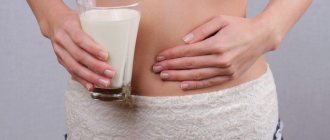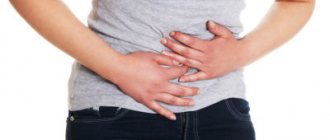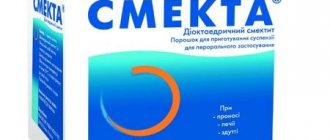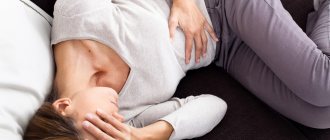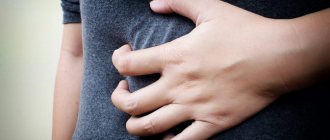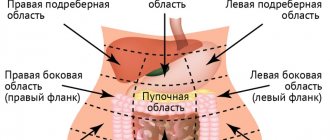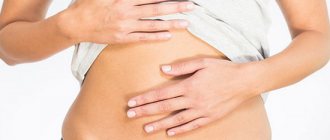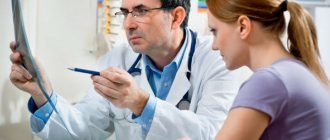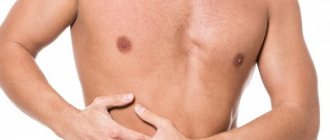02/07/2019 Alena Masheva Health
What to do if the esophagus in the thoracic part hurts? The esophagus is the part of the digestive tract that is located between the pharynx and the stomach. If you experience severe pain in the esophagus, you should consult a doctor. After a thorough medical examination of the patient, the doctor will make an accurate diagnosis and identify the factor that provoked the development of the disease. To prevent the development of serious health problems, it is important to carry out therapy in a timely manner. Self-medication is not recommended; this will only worsen the course of the disease.
Main reasons
Why does the esophagus in the chest hurt? There are several reasons why pain may occur:
- With esophagitis, a strong inflammatory process occurs in the alimentary canal due to exposure to gastric juice. During the development of this disease, a person experiences discomfort in the chest area while swallowing food. In addition, there is severe heartburn and a burning sensation.
- Injury to the esophagus often provokes pain in the affected area. The damage can be internal or external.
- Due to a functional disorder of the esophagus, the motor function of this organ is disrupted, without any visible change, a burning sensation occurs, and the esophagus hurts in the thoracic part. Treatment of this disease is carried out by a psychotherapist and gastroenterologist. With this diagnosis, a person experiences severe spasms and pain in the esophagus. This disorder appears due to the influence of a mental factor - systematic nervous experiences, a depressive state. You can temporarily improve your well-being with the help of No-Shpa. The doctor may prescribe a sedative.
- Severe burn. As a result of the burn, a lump often appears in the throat, the esophagus in the chest part hurts, and it is painful to swallow food. Unpleasant symptoms occur when various chemical compounds or acids enter the body. Under such conditions, the esophageal mucosa can be severely damaged. In this case, you must urgently call an ambulance. It is not recommended to self-medicate, since the consequences can be unpredictable, including disability.
Sometimes the esophagus in the thoracic part hurts greatly due to the introduction of a foreign body into it - small grains, a denture, a button, a nail, a paper clip, fish bones. Unpleasant sensations may occur due to the use of a tracheostomy tube. Anyone can accidentally swallow such foreign objects due to:
- inattentive preparation of food;
- eating food on the run;
- poor quality of chewing food - under such conditions the patient will not feel foreign objects in the mouth.
It is not recommended to keep a toothpick or other small objects in your mouth while cooking. You should know that a foreign body that gets into the esophagus can cut it. If a person finds any object in this area, it is necessary to call an ambulance or visit a doctor, this will help prevent the development of serious health problems.
Causes of pain in the esophagus
To find out whether the pain is related to the esophagus, you first need to track whether it occurs only when swallowing or not.
Painful swallowing is medically called “odynophagia,” and difficult but not painful swallowing is called “dysphagia.” If the pain is not associated with swallowing at all, then it is called spontaneous.
Useful article? Share the link on VKontakte
Odynophagia most often begins with dysphagia, that is, with difficulty passing a food coma through the pharynx and esophagus.
If treatment is not started on time, difficulty swallowing will soon be complicated by pain.
Discomfort behind the sternum after swallowing clearly indicates that its source is in the esophagus. Odynophagia is always accompanied by changes in the mucous membrane of the esophagus.
Your doctor may look for the following causes of painful swallowing:
- burns from chemicals or hot drinks;
- infectious diseases, especially viral ones;
- inflammation and erosion that occurs after taking certain medications;
- backflow of food down the esophagus (reflux);
- esophageal tumor.
The intensity of pain can vary - from minor, occurring only when eating solid food, to severe, accompanying every sip. Symptoms of severe odynophagia lead to the patient refusing to eat at all.
In addition to pain after swallowing, other symptoms may indicate diseases of the esophagus.
The medical literature describes a case where, due to an ulcer in the esophagus caused by taking a dietary supplement, the patient simultaneously had symptoms of odynophagia and dysphagia, complicated by spontaneous pain behind the sternum, not at all associated with swallowing.
If a person has pain in the esophagus when swallowing, then you should not immediately suspect the most unpleasant reasons.
In fact, the most common pain sensations behind the sternum are symptoms of malignant tumors.
The most common cause of pain in the esophagus is reflux, that is, the reflux of food from the stomach back into the esophagus. This happens to everyone from time to time.
If reflux is regular, then this indicates a pathology, which can be treated with medication.
Statistics say that in half of cases of non-cardiac chest pain, the culprit of discomfort is reflux.
In this case, the pain is not necessarily concentrated behind the sternum - in certain cases it even radiates to the back.
If chest discomfort is not associated with eating or heartburn, then it will be more difficult to establish its causes, since cardiac, pulmonary, muscular or skeletal pain may be localized in the thoracic region.
Perforation of the esophageal wall
This pathological condition often develops as a result of cancer, chemical burns and ulcers. With this diagnosis, the esophagus in the thoracic part hurts greatly - this is the main symptom of the disease, which has a paroxysmal, increasing character. Under such conditions, the patient’s death is possible, since the person’s esophagus can simply rupture. As a result, terrible pain appears, severe coughing and the functioning of the respiratory system is disrupted. In addition, the patient may experience severe vomiting. In this case, it is important to call an ambulance and not self-medicate.
The relationship between cardiopathy and discomfort in the esophagus
Oddly enough, the feeling that there is a lump in the esophagus can be one of the signs of heart problems.
Such symptoms are caused by angina pectoris, ischemic heart disease, and atherosclerosis of the heart vessels. At the same time, a feeling of a lump in the esophagus and a strong cough appear as the first “bells”. Next join:
- burning behind the sternum and in the epigastrium;
- pain radiating to the left half of the body: shoulder blade, shoulder, neck;
- sudden weakness;
- breathing disorder.
The first thing to do in such a situation is to call emergency help, move independently if possible, and consult a cardiologist.
Cancers
Cancers of the esophagus most often appear in those people who lead an unhealthy lifestyle - they smoke a lot and drink alcohol excessively, and regularly inhale harmful chemical fumes. To reduce the risk of developing pathology, it is important to lead a healthy lifestyle. Do not overuse spicy or hot foods. Warm food is the best option. If a person develops cancer, the following symptoms occur:
If one of the symptoms appears, you need to visit a doctor. At the initial stage of disease development, therapy is carried out much faster and more effectively. If you do not contact medical personnel in a timely manner, therapy will be carried out using the surgical method in a hospital setting.
Possible diseases
Esophagitis is an inflammation of the lining of the esophageal tube.
The disease is the most common among all organ lesions. Inflammation can damage the deep layers of the esophagus. Its causes include injuries, burns, infections, and allergies. The disease can occur in both acute and chronic forms. It manifests itself as a sensation of a lump in the esophagus, a stake in the sternum, or distension. The patient complains of heaviness, lack of air, as if something is preventing him from swallowing and breathing. Reflux is a disorder associated with esophagitis. It is manifested by the release of stomach contents into the esophagus. This causes the acidic component to irritate its walls, leading to inflammation. The severity of symptoms will depend on the duration of the pathological process, the frequency of reflux, and the ability of the organ walls to resist an acidic environment. Without treatment, this disorder will cost the normal ability to swallow food with other severe complications.
Malignant tumor - a neoplasm on the wall of the esophagus will lead to various symptoms, including pain. Cancer is accompanied by spasms; the neoplasm blocks the lumen of the organ, which interferes with the passage of food. This will be accompanied by dull pain behind the sternum and dysphagia. When the esophagus hurts due to cancer, symptoms from other organs will not appear immediately. The long, latent course of oncology is life-threatening, so it is important to be examined by a doctor at the first warning signs.
A hiatal hernia is a condition in which part of the stomach and abdominal esophagus passes through a weakened hole in the diaphragm into the chest. The pathology is characterized by an asymptomatic course. A hernia produces temporary and vague symptoms. The patient may feel discomfort behind the sternum, and it is painful for him to bend forward after eating. Main manifestations: dyspepsia after eating in the form of heartburn, belching, hiccups, lump in the chest.
You can check for the presence of a hernia using an x-ray or other imaging methods, because an esophageal hernia does not appear externally. The diaphragm will put pressure on the organs, disrupting their function, and therefore other digestive disorders may appear.
Common pathologies
During the development of gastrointestinal diseases, a burning sensation occurs, the esophagus in the chest hurts - the treatment of this pathological condition is carried out by a gastroenterologist. Only after a thorough medical diagnosis will the doctor be able to identify the main reason for the deterioration of the patient’s general condition:
- A hiatal hernia is a chronic pathological process in which the esophagus can become displaced.
- Esophagitis provokes the development of an inflammatory process in the esophagus. When a hernia appears, painful sensations occur in the chest, which intensify after active movement, coughing or while eating.
- With a diverticulum of the esophagus, the walls of this organ protrude. Several diverticula may be present in the esophagus. Most often, the disease appears in a person who has pliability of the walls of the esophagus to pressure. Among the main symptoms of this pathological condition are the sensation of foreign bodies in the larynx and frequent regurgitation.
- With achalasia of the esophagus, this organ expands. The disease develops as a result of eating cold foods and acute lack of vitamins (B1), and systematic stress. During the development of achalasia, the patient is bothered by a dull pain in the chest area that radiates to the back. Systematic nausea also causes discomfort.
- Due to disturbances in the functioning of the nervous system, pain may occur in the esophagus, since cranial nerves are responsible for the functioning of this organ, which can cause its relaxation. With a strong emotional experience, this balance can be disrupted, which provokes the development of spasms and pain in the esophagus.
- With an ulcer, pancreatitis, heart attack, hypertension, tachycardia, arrhythmia, pain in the esophagus often develops. Under such conditions, it is important to immediately visit a doctor and begin comprehensive treatment. Any medications should be taken strictly according to the recommendations of the treating specialist.
Additional symptoms: what does it indicate and what does it mean?
Spasm can appear in any part of the esophagus, and especially in the sphincter area. This is explained by the fact that sphincters have many nerve endings. For one type of patient, sharp and cutting pain is characteristic, while others experience a feeling of discomfort of a “lump” in the chest area. This pain is often mistaken for heart pain. The pain syndrome can last for several seconds, and in some cases for about an hour at a time, which forces patients to use antispasmodics.
The main signs of pain are:
- pain that manifests itself between the shoulder blades;
- pain in the chest area;
- radiating pain to the ears, back, jaw or arm;
- dysphagia of varying degrees (inability to swallow food);
- painful spasm radiating to the chest (occurring during exercise).
Serious difficulties with swallowing food can occur when consuming food of any consistency, and in some cases, when consuming drinks. Pain and problems with swallowing can also occur separately.
Important: Some patients experience pain in unusual conditions, for example, at rest, during sleep or while swallowing saliva.
Esophageal spasm is divided into acute and chronic. The chronic type of spasm is typical for people who are especially susceptible to anxiety. Such people experience a painful or uncomfortable feeling of constriction in the upper esophagus and a desire to drink even liquid and porridge foods.
Main symptoms
If spasms of the esophagus occur, the patient exhibits the following symptoms:
If one of the symptoms appears, you should visit a doctor. Based on the patient’s diagnostic results, the specialist will prescribe effective therapy.
General symptoms
Impaired functionality of the esophagus is accompanied by certain symptoms. Their severity is interconnected with the existing disease and its stage.
Painful sensations appear in the sternum area. They are created by involuntary contraction of the esophagus or stretching of its walls. Unpleasant sensations occur when food passes through the esophagus and can last several minutes or a few seconds. Some of the pain radiates to the back or other areas - ear, jaw, neck. Along with this sign, other symptoms usually appear:
- Swallowing disorder. At first, the problem manifests itself only when hastily eating food or during times of strong excitement. It feels like I swallowed a pill poorly. Difficulty is common when swallowing solid foods. After eating there is a pressing feeling in the chest area. Breathing becomes heavy and heart rate increases.
- Belching. It manifests itself in different ways. Occurs immediately after eating or after a certain period of time. Belching is often provoked by stress, tilting or tension of the peritoneum. Possible vomiting.
- Heartburn.
Important! It is necessary to find out why the esophagus hurts. To do this, you need to contact a specialist who will not only conduct a general examination, but also give a referral for the necessary laboratory and instrumental diagnostics. X-rays of the esophagus and stomach and endoscopy or esophagogastroduodenoscopy (EGD, gastroscopy) are often prescribed.
Patient Actions
If the esophagus hurts in the chest, what should you do? What pills can you take if you experience severe pain in the esophagus? Pain in the esophagus can occur unexpectedly. Under such conditions, there is no need to sound the alarm; this will not help solve the problem. It is better to follow the following recommendations from experts:
- If discomfort occurs after eating, then you need to drink warm water - one glass without gas.
- Inhale and exhale slowly, hold your breath for a few seconds.
- Take a sedative. Thanks to Persen you can improve your well-being.
- Chamomile tea can relieve cramps and calm you down.
- Mint candies will help normalize the functioning of the respiratory system and improve well-being.
If systematic pain in the esophagus occurs, you should seek help from a qualified medical professional: this may indicate that serious pathologies are developing.
5. Osteochondrosis, protrusion or hernia of the thoracic spine
Pain in the esophagus area often appears when a nerve is pinched by a displaced vertebra or hernial protrusion.
Causes
Hernias or osteochondrosis lesions of the intervertebral discs provoke:
- destructive processes of cartilage tissue;
- spinal column injuries;
- sedentary lifestyle;
- long-term static loads.
The pathology develops slowly and can be almost asymptomatic for a long time, and then, with a sudden movement, the vertebral structures are displaced, squeezing the nerve root, and pain appears in the esophagus in the chest.
Symptoms
A distinctive sign of osteochondrosis is that the esophagus hurts regardless of food intake.
The intensity of pain depends on the degree of compression of the nerve. Severe pain in the esophagus will appear if the root is under great pressure on the root, and moderate pain discomfort will occur with slight compression.
The pain will intensify with movement.
Treatment
The spine needs to be treated. After eliminating the infringement of the nerve process and restoring full innervation, the esophagus will stop hurting. Patients are prescribed:
- non-steroidal anti-inflammatory drugs;
- analgesics;
- local application of ointments with anti-inflammatory and analgesic effects;
- chondroprotectors.
To prevent repeated displacements, patients are selected a complex of exercise therapy that allows them to build up a natural muscle corset that supports the anatomical position of the spinal column.
How to carry out treatment?
When the esophagus in the thoracic part hurts severely, what should you do and what drug will help eliminate the pain? Based on the diagnostic results obtained, the doctor will diagnose the patient and prescribe drug therapy, which includes taking the following medications:
- With the help of “Papaverine”, “No-Shpa”, “Atropine”, spasms can be eliminated. The dosage will be determined by your doctor. The tablets should be taken before meals.
- With the help of Trazodone and Novo-Passit you can get rid of feelings of anxiety, neurosis and depression. It is recommended to visit a psychologist and psychotherapist; this will help speed up the patient’s recovery process.
- If the patient has severe pain that interferes with leading a full and normal lifestyle, then you need to take an anesthetic drug. Thanks to Novocain and Anestezin, you can temporarily improve your health if the esophagus in the chest hurts when swallowing. You should know that painkillers do not affect the development of the disease, so it is not recommended to use them systematically. The dosage of Novocaine will be determined by the doctor. This drug should not be used other than as prescribed by a doctor.
- An enveloping medication should be taken if the esophagus in the thoracic part hurts. Burning and discomfort can be eliminated with the help of Phosphalugel. To reduce pain, it is necessary to treat with coating medications that will help protect the esophageal mucosa. "Almagel" is the most effective and safe drug.
- If there is a reflux of acid from the stomach, the doctor prescribes physiotherapeutic treatment for the patient - chloride electrophoresis on the area of the cervical nerve nodes.
You should know that during therapy it is important to eat a healthy and balanced diet. It is not recommended to abuse spicy and fatty foods, this will only delay the patient’s recovery process. You can check the detailed menu with your doctor.
Treatment of pain in the esophagus
Treatment is prescribed after all examinations have been completed and depends on what causes of pain are discovered.
You can reduce the discomfort of a sick person not only with antispasmodics, but also by relieving anxiety and fear with the help of sedatives and antidepressants.
For chest pain, hypnosis helps well. Treatment of the nervous system using physiotherapy also gives good results. For this purpose, electrophoresis of the cervical nerve ganglia and a galvanic collar are used.
Video:
If a person experiences severe cramping pain during or after eating and because of this he refuses to eat, the doctor may supplement the treatment with local anesthesia (Novocaine).
You can relieve spasms with calcium antagonist drugs: Nifedipine, Diltiazem. The doctor may prescribe an epithelial coating agent, such as Simethicone.
If the cause of the pain is reflux, then antacids based on aluminum and magnesium, which neutralize stomach acid, will help to cope with it. A nitroglycerin tablet placed under the tongue quickly relieves pain.
In case of severe pain, an intravenous infusion or an intramuscular injection of atropine is used as a one-time measure.
The doctor should be especially alert if the pain after an atropine injection disappeared an hour later and immediately began again - these are symptoms of functional intussusception of the esophagus.
Herbal medicine is also effective in treating diseases of the esophagus. If, with pain behind the sternum, the doctor diagnoses a disease of the esophagus, this means that you need not only to be treated with medications and herbs, but also to follow a diet.
Food will have to be taken in liquid and pureed form. There should be no solid particles in it. It is important that food and drinks are warm - hot and cold foods are excluded.
If the cause of the pain is heartburn, then you need to exclude fatty and spicy foods and raise the head of the bed an additional 10 - 15 cm.
Herbal infusions, which include herbs that normalize the secretion of gastric juice and relieve inflammation, can be a good aid to drug treatment.
They may include:
- angelica;
- St. John's wort;
- plantain;
- chamomile.
Multicomponent collection against inflammation of the mucous membrane of the esophagus and other gastrointestinal organs:
- cottonweed;
- chamomile;
- celandine;
- St. John's wort;
- plantain;
- calendula;
- oat grains;
- rosehip berries.
Take a teaspoon of all ingredients, grind in a coffee grinder, pour boiling water in a thermos and leave overnight. In the morning, strain and drink a few sips before meals. You can add honey (no sugar!).
If the cause of pain in the esophagus is not congenital anomalies, malignant tumors or foreign bodies entering it, then treatment will consist only of taking medications and following a diet.
A qualified doctor can easily determine the cause of chest pain and prescribe treatment that will definitely help get rid of the discomfort forever.
Painful sensations in the stomach occur quite often and the patient, by the nature and location of the pain, can most often easily determine the cause of its occurrence - overeating, eating food that is heavy for him or an exacerbation of chronic diseases of the stomach, liver, pancreas.
But it happens that the pain in the stomach radiates to the throat, there is a burning sensation in the esophagus, a coma in the larynx.
Why does this happen? Which symptom - pain in the stomach or throat - indicates a disease, and which is a side effect? This article will answer these questions.
Medical nutrition
Thanks to proper nutrition, you can not only improve your overall health, but also speed up the recovery process for patients with diseases of the esophagus. In the process of treating pathology of this organ, it is recommended to include in the diet:
If the esophagus in the chest hurts when swallowing, you need to follow a diet. Do not use:
In addition, you must follow the following recommendations from specialists:
- Consume food slowly: it is important to chew each bite thoroughly.
- Eat small meals - up to 6 times a day. Portions should be small.
- Regularly consume fermented milk products.
- Food should be warm, not hot or cold.
- While consuming food, you should not drink water.
- Food must be boiled or baked.
- It is better to grind difficult-to-digest foods using a blender; this will reduce the risk of injury to the esophagus.
- It is recommended to consume food at the same time.
Thanks to such simple recommendations, you can improve your overall health and the functioning of your gastrointestinal tract.
Preventive measures
The main preventive measure is proper nutrition and adherence to the regime. This means not only eating healthy food, but also doing it in the right way. It is necessary to prevent injury to the esophagus by chewing food thoroughly and slowly. You need to swallow food in small portions, it should be at a comfortable temperature.
Bad habits will contribute to damage to the esophagus. It is necessary to give up alcohol or minimize its consumption, and fight smoking addiction. An equally harmful habit would be overeating, eating a large amount of food at one time. Even if a person does not eat enough calories per day, if they all come in one meal, this is stressful for the body. In addition to problems with digestion and metabolism, this will lead to a number of symptoms characteristic of diseases of the esophagus.
When pain in the esophagus begins to bother you regularly, you need to make an appointment with a gastroenterologist. It is usually possible to eliminate the symptom with a course of medication and the use of folk remedies. In some cases, complex and lengthy treatment will be required.
Common diseases of the esophagus: treatment
If the esophagus in the chest hurts and heartburn causes a lot of inconvenience, it is necessary to undergo a medical examination, since this is a sign of the development of the disease. Gastric erosion is one of the most common diseases of the digestive system. To cure the pathology, you need to eat right and take the medications prescribed by the doctor. You can restore the esophageal mucosa using the following drugs:
How to eliminate the unpleasant symptoms of this pathology? With the help of alginates, you can temporarily improve the patient's well-being. The active substances of the drugs interact with gastric juice and suppress its acidic environment. Under such conditions, a protective film is formed on the surface of the esophagus. Thanks to this, the unpleasant symptoms of the disease are eliminated - heartburn, burning sensation, soreness. With the help of prokinetics, you can eliminate gag reflexes and stimulate gastric motility. If the esophagus hurts in the chest and a lump in the throat appears due to erosion of the esophagus, then you need to take Motilium tablets. With the help of this medication, erosion of the esophagus, flatulence, bloating, and heartburn are treated. The duration of therapy should be determined by the doctor, depending on the severity of the pathology and the severity of the manifestation of unpleasant symptoms.
Discomfort in the esophagus as a result of stress
The phrase “I got a lump in my throat from the experience” has a physiological basis. With strong emotions, both negative and positive, a spasm of the muscles of the larynx, pharynx, and upper part of the esophagus occurs. This results in a feeling of lack of air and an unpleasant sensation of a lump in the esophagus.
In emotionally stable people, such phenomena are short-lived, pass quickly and without consequences. Long-term persistence of symptoms is observed:
- in people of the neurasthenic type, prone to frequent mood swings;
- in childhood during prolonged stressful situations (quarrels between parents, divorce, change of place of residence or study, exams);
- in women during pregnancy or menopause;
- when working with increased attention and responsibility.
In this case, the following help to get rid of a lump in the throat: walks in the fresh air, psychotherapeutic assistance, taking light sedatives, a change of environment.
How to take painkillers correctly?
Many patients experience increased pain in the stomach after taking painkillers. The problem is that many people do not study the instructions for use of medications and do not consult with their doctor. To avoid this problem, you need to remember the following recommendations from experts:
- Take the drug "Gastal" 3 tablets a day, which should be divided into several doses - 2 or 4. Take the medicine 20 minutes before meals or before bed.
- If severe pain occurs in the esophagus, then you need to take Maalox - two tablets after meals. The pills should be completely dissolved.
- "Controloc" is suitable for long-term treatment. The duration of the course of therapy is 1-3 weeks. Depending on the severity of the disease and the specific clinical picture of the patient, the doctor will determine the dosage. The recommended dose is 1-2 pills per day.
- "No-Spa" is an effective antispasmodic that eliminates pain in the stomach area. You should take 1-2 tablets (three times a day). If after using the drug your overall health does not improve, you should call an ambulance or consult a doctor: this may indicate that a serious illness is developing.
The esophagus hurts in the chest and there is a lump in the throat, what should I do? Stomach pain is a symptom of the development of a dangerous pathology. Gastritis, ulcers, reflux esophagitis are common causes of pain. There is no need to take painkillers regularly. This only masks the underlying disease, but does not affect its development. You should definitely visit a doctor.
Diet, treatment and prevention
Dietary nutrition when pain in the stomach and esophagus occurs is incredibly important. It allows for a kind of unloading and relieves the esophagus from excessive strain. Therefore, in order to achieve tangible results, you must strictly adhere to the following recommendations:
- do not overeat;
- give up excessively rough food;
- chew food thoroughly;
- exclude spicy, salty, smoked, fried foods from the diet;
- stop eating raw vegetables;
- include porridge, cream soups, purees in your diet;
- drink more water.
If the problem that caused the pain is not critical, then diet and rest give the desired results within the first days. You should not rely on the effectiveness of the diet if you periodically ignore a number of rules.
In order for the treatment result to be consolidated, it is necessary to provide yourself with peace, namely, not to overexert yourself physically, and to avoid accidental mechanical damage.
If there is no result, the problem should be eliminated with medication. So, by contacting a gastroenterologist, you need to undergo a series of examinations and establish the process of normal food intake.
In some cases, patients are prescribed herbal medicine. It allows you to replenish the water balance and at the same time has a quickly healing effect. Thus, doctors recommend using tea with chamomile, mint and St. John's wort for pain in the esophagus. This helps relieve inflammation, reduces the urge to vomit and further increases the protective properties of the immune system.
Note to patients
“If the esophagus hurts in the chest and there is a lump in the throat, which doctor should I see?” - many patients ask. If pain systematically occurs in the esophagus, then most likely this is a sign of the development of a dangerous pathology. Under such conditions, it is important to seek help from a gastroenterologist and undergo a thorough medical examination. Based on the diagnostic results obtained, the attending physician will prescribe a comprehensive treatment. During therapy, it is necessary to follow a diet, since many foods irritate the mucous membranes, which causes complications.
If a lump appears in the throat and the esophagus in the chest hurts after drinking alcohol, this may be a sign of the development of pancreatitis. You should lead a healthy lifestyle - do not smoke or abuse alcoholic beverages. Doctors do not recommend systematically taking painkillers; this only masks the disease and aggravates its course. The duration of medication treatment and dosage must be determined strictly by the doctor, depending on the individual and physiological characteristics of the patient’s body. If the patient has other serious illnesses, the doctor is especially careful when choosing a treatment method. Traditional methods of treatment should be used only after consulting a medical professional. You shouldn't risk your health. If you have a lump in your throat and the esophagus in the chest hurts during pregnancy, you should drink No-Shpu and consult your doctor. Self-medication can harm the baby and the expectant mother.
Source: fb.ru
Signs of pathology
If the esophagus hurts, you need to pay attention to the accompanying symptoms. The nature and regularity of the expressed symptoms may indicate a serious illness or an isolated case of unpleasant sensations.
The main symptoms of pain in the esophagus are:
- dysphagia;
- spasms;
- feeling of heaviness;
- heartburn;
- belching;
- tightness in the chest area;
- vomiting mixed with mucus and blood;
- unpleasant odor from the mouth.
The occurrence of symptoms is associated with the causes of pain in the area of the esophageal tube. Common signs include dysphagia, severe cramping, and a sensation of a foreign body being stuck. In severe cases of esophageal dysfunction, problems with swallowing solid food are observed. Heartburn and belching are a consequence of reflux disease, esophagitis. A feeling of heaviness and constriction is characteristic of a malignant tumor that affects the walls of the esophageal tube.
During the inflammatory process, strong discharge of vomit mixed with blood and mucus appears. Putrid odor from the mouth is observed when the functioning of the lower esophageal sphincter is impaired.
Causes
The main cause of inflammation of the esophagus is increased acidity in the stomach. Under normal conditions, the esophagus is protected by a special sphincter, which prevents the contents of the digestive organ from moving in the opposite direction. An increased amount of hydrochloric acid causes inflammation of the stomach and reduces the tone of the sphincter muscles. As a result, acid enters the esophagus and burns the mucous membrane. There are no significant painful sensations, but the main symptom is a sour taste in the mouth. Belching and heartburn may occur.
Experts say the main provoking factor is a disrupted diet and poor diet. Direct inflammation of the throat occurs with frequent consumption of hot drinks, carbonated drinks, alcoholic drinks with a high alcohol content. Spicy, fatty, salty foods, sweets provoke an increase in acidity, the development or exacerbation of gastritis. Then the esophagus becomes inflamed. Since everything in the digestive system is interconnected, gastritis, gastroduodenitis, and colitis can provoke esophagitis.
Recently, experts keep reminding that the cause of gastritis is the bacteria Helicobacter pylori, which, with reduced immunity, begin to multiply. They, as well as a reduced protective reaction, can be provocateurs of inflammation of the esophagus. Esophagitis can be caused by an infection or virus. The situation is especially common with prolonged vomiting.
The cause of esophagitis can be instrumental methods of examining the gastrointestinal tract. A device with a hose is inserted through the mouth, which is lowered into the stomach and small intestine. If the size is incorrectly selected or the specialist is poorly qualified, side effects appear after the procedure. In addition, esophagitis can be the cause of allergies, autoimmune transformations - food, contact, bronchial asthma.
Provoking factors:
- Spicy, fatty, too hot food;
- Overweight, obesity;
- Increased intra-abdominal pressure;
- Sphincter pathology;
- Metabolic disorders, endocrine diseases;
- Medicines;
- Chronic inflammatory processes in the body.
All diseases manifest themselves and worsen when the body’s protective functions decrease, so weak immunity can also be called the cause.
